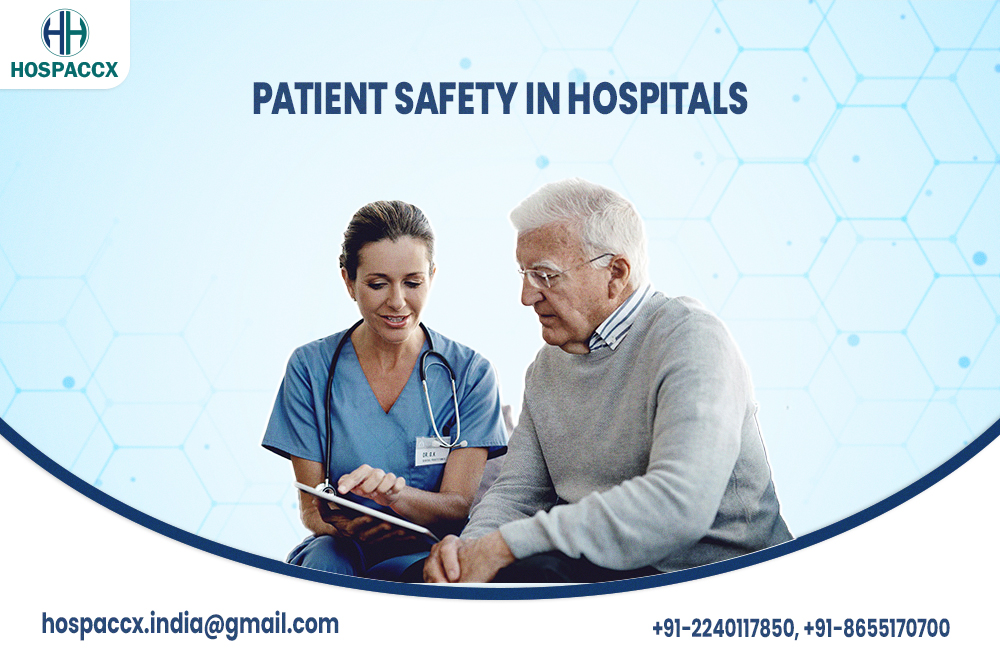PATIENT SAFETY IN HOSPITALS
Are you planning to open your own hospital or invest in the same? In this article Hospaccx Healthcare Consultancy has explained in detail about Patient safety, its importance and some important tips to maintain it in Hospitals.
Why patient safety is so important?
- The first principle of Health Care service is “first to do no harm” (‘Primum non nocere (Latin)’, Hippocrates oath). With advancement of Medical Technology, more so in last few decades, patient care processes have become more complex.
- Patient care requires optimum coordination between Healthcare providers (doctors, nurses, technicians, etc), technology (like CT Scan, MRI, C Arm, etc), drugs, work-practices, processes, etc.
- This makes modern hospitals one of the most vulnerable and high-risk places, prone for making mistakes that may result in death or serious injuries to patients, whom it is supposed to cure.
- In India, though precise data is not available regarding medical errors, it is estimated that around 5.2 million injuries occur due to medical errors, resulting in around 3 million preventable deaths every year. For every 100 Hospitalization average 12.7 adverse events occurs. (Ashish Jha, BMJ Quality & Safety, Sept 2013).
- Mishaps from medications, hospital-acquired infections and blood clots that develop in legs from being immobilized in the hospital (post-operative, after surgery & plaster, prolonged convalescence, unconscious patient) are the biggest source of adverse events.
- Statistically it has been estimated that there is 1:100,000,000 (100 million) chance of Nuclear Power Plant Accident, 1:10,000,000 (10 million) chance of Airline Crash, while for the Preventable Hospital Death, the chances are 1: 300 (Lucian Leape 2001). This shows vulnerability of the patients in hospitals.
What constitutes Patients Safety?
Physical Safety –
This includes safety of health care infrastructure including- a. Designing, planning and maintenance of hospital infrastructure – e.g. Location of critical departments, segregation of general and patients traffic within the hospital, provision of ramps, and annual preventive maintenance of the facility. It also includes the measures taken for making building earthquake resistant especially in earthquake prone area.
Safety of electrical installation –
Secured wiring, adequate earthing, availability of standard and adequate power outlets, display of danger signs and a system of periodic check-up and power audit of electrical installations in the hospital, special areas requiring high power load (ICU, Cardiac care unit, SNCU) are few areas, needing special attention for the safety.
Safety of engineering and support services –
This includes safe installation & operations of hospital equipment, periodic inspections & maintenance, mandatory alternate electric supply, intercom connection, Emergency alarm system for lifts and central oxygen and vacuum supply, regular inspection of water quality as well adequate alternate power backup arrangements especially for critical areas like ICU, SNCU, OT and Labour room.
Fire Safety –
This includes availably of fire extinguisher (correct type, adequate in number at correct location, skill to use them), fire exit plan, training and mock drill of staff for using firefighting equipment and evacuation.
Safe Environment in Hospital –
Clean and hygienic environment in patient care areas is essential for providing safe care. This includes:
- a) Proper cleaning and decontamination of patient care and procedure areas like labour table, OT, wards, injection rooms, dressing room, etc.
- b) Proper segregation, storage and disposal of biomedical waste as per guidelines (Biomedical Waste Rules 1998)
- c) Ensuring adequate air exchanges especially in high-risk area ICU, SNCU, OT, etc.
- d) Proper sewage disposal and prevention of water logging in health care facility
- e) Measures for preventing rodents, pest control and stray animals in patient care
Safety of Clinical Care –
- Infection Prevention Practices –
- Ensuring proper hand washing practices among the care providers (provision for hand washing facilities, correct technique (6-steps), and ensuring practices) ii. Proper disinfection/ sterilization of surgical instruments and surfaces
- Use of personal protection equipment’s like gloves, masks, apron, etc.
- Periodic immunization and medical check-up of the care providers
- Medication Safety –
- Proper identification of patient before drug administration,
- Double check of drug and dosages of high alert medicines,
- Maintenance of expiry dates of drugs,
- Segregation of ‘look alike and sound alike’ drugs (e.g. Digene & Digoxin (for heart), Fortwin & Fortam, Daonil & Dapsonil), and
- Ensuring that medical orders are written in legible and comprehendible writing.
- Identification and monitoring of vulnerable and high-risk patients (old age, children, stupors/ comatose patients, under drugs / sedation, domestic violence victims, etc.)
- Proper identification of surgical sites and use of surgical safety checklists (WHO check-lists)
- Monitoring and reporting of adverse events like hospital acquired infections and adverse drug reaction. It helps in taking preventive action
SOME IMPORTANT TIPS TO FOLLOW PATIENT SAFETY ARE-
Medical errors may occur in different health care settings, and those that happen in hospitals can have serious consequences. The Agency for Healthcare Research and Quality, which has sponsored hundreds of patient safety research and implementation projects, offers these 10 evidence-based tips to prevent adverse events from occurring in your hospital.
- Prevent central line-associated blood stream infections.
Be vigilant preventing central line-associated blood stream infections by taking five steps every time a central venous catheter is inserted: wash your hands, use full-barrier precautions, clean the skin with chlorhexidine, avoid femoral lines, and remove unnecessary lines. Taking these steps consistently reduced this type of deadly health care-associated infection to zero in a study at more than 100 large and small hospitals.
2. Re-engineer hospital discharges.
Reduce potentially preventable readmissions by assigning a staff member to work closely with patients and other staff to reconcile medications and schedule necessary follow up medical appointments. Create a simple, easy-to-understand discharge plan for each patient that contains a medication schedule, a record of all upcoming medical appointments, and names and phone numbers of whom to call if a problem arises. AHRQ-funded research shows that taking these steps can help reduce potentially preventable readmissions by 30 percent.
3. Prevent venous thromboembolism.
Eliminate hospital-acquired venous thromboembolism (VTE), the most common cause of preventable hospital deaths, by using an evidence-based guide to create a VTE protocol. This free guide explains how to take essential first steps, lay out the evidence and identify best practices, analyse care delivery, track performance with metrics, layer interventions, and continue to improve.
4. Educate patients about using blood thinners safely.
Patients who have had surgery often leave the hospital with a new prescription for a blood thinner, such as warfarin brand name: Coumadin®, to keep them from developing dangerous blood clots. However, if used incorrectly, blood thinners can cause uncontrollable bleeding and are among the top causes of adverse drug events. A free 10-minute patient education video and companion 24-page booklet, both in English and Spanish, help patients understand what to expect when taking these medicines.
5. Limit shift durations for medical residents and other hospital staff if possible.
Evidence shows that acute and chronically fatigued medical residents are more likely to make mistakes. Ensure that residents get ample sleep and adhere to 80-hour workweek limits. Residents who work 30-hour shifts should only treat patients for up to 16 hours and should have a 5-hour protected sleep period between 10 p.m. and 8 a.m.
6. Consider working with a Patient Safety Organization.
Report and share patient safety information with Patient Safety Organizations (PSOs) to help others avoid preventable errors. By providing both privilege and confidentiality, PSOs create a secure environment where clinicians and health care organizations can use common formats to collect, aggregate, and analyse data that can improve quality by identifying and reducing the risks and hazards associated with patient care.
7. Use good hospital design principles.
Follow evidence-based principles for hospital design to improve patient safety and quality. Prevent patient falls by providing well-designed patient rooms and bathrooms and creating decentralized nurses’ stations that allow easy access to patients. Reduce infections by offering single bedroom, improving air filtration systems, and providing multiple convenient locations for hand washing. Prevent medication errors by offering pharmacists well-lit, quiet, private spaces so they can fill prescriptions without distractions.
8. Measure your hospital’s patient safety culture.
Survey hospital staff to assess your facility’s patient safety culture. If your health system includes nursing homes or ambulatory care medical groups, share culture surveys customized for those settings.
9. Build better teams and rapid response systems.
Train hospital staff to communicate effectively as a team. A free, customizable toolkit called TeamSTEPPS™, which stands for Team Strategies and Tools to Enhance Performance and Patient Safety, provides evidence-based techniques for promoting effective communication and other teamwork skills among staff in various units or as part of rapid response teams. Materials can be tailored to any health care setting, from emergency departments to ambulatory clinics.
10.Insert chest tubes safely.
Remember UWET when inserting chest tubes. The easy-to-remember mnemonic is based on a universal protocol from the Joint Commission and stands for: Universal Precautions (achieved by using sterile cap, mask, gown, and gloves); Wider skin prep; Extensive draping; and Tray positioning. A free 11-minute DVD provides video excerpts of 50 actual chest tube insertions to illustrate problems that can occur during the procedure. Ordering information for Problems and Prevention: Chest Tube Insertion.
CONCLUSION
Patient safety is directly proportional to patient satisfaction. Hence it should be of utmost importance in any hospital.
It is a superficial macro level study. For more details kindly contact Hospaccx Healthcare business consulting Pvt. Ltd on Hospaccx.india@gmail.com
Related Team Members




















